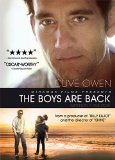There’s a quote by author Kent Nerburn that says: “It is much easier to become a father than to be one.” The Boys Are Back, based on a memoir by Simon Carr, is the best example of that sentiment on film that I’ve personally seen in a few years. Clive Owen plays sportswriter Joe Warr. He’s good at becoming a father, but not at being one. His one-the-go job keeps him from spending any real quality time with his family, leaving his wife Katy (Laura Fraser) to raise their son Artie (Nicholas McAnulty). When Katy becomes fatally ill, Joe must step up to the plate to take care of his 6-year-old son. His mother-in-law (Julia Blake) tries to offer her advice, but Joe is determined to do it on his own.
Widower Joe must deal with Artie, a firecracker of a boy he knows nothing about, foreign events like parent-teacher conferences, and keeping on the ball with his deadlines at the newspaper. He adopts a hands-free parenting philosophy that allows Artie to have the run of the house with as few rules as possible. That plan is full of flaws from the start.
A fellow single parent from school, Laura (Emma Booth), offers much needed support and a pair of helping hands, but the relationship becomes more complicated than Joe is emotionally capable of handling. Laura soon recognizes her role has changed from friend to stand-in caregiver. The tension is amplified when his quiet, 14-year-old son from a previous marriage, Harry (George MacKay), comes to stay for a while. Joe’s irresponsibility as a parent and inability to cope with his grief hurts all parties involved.
Harry is the outsider here, and he struggles with getting to know a father who abandoned him at an early age. Joe begins to see the flaws in his parenting strategy when the house is a pigsty and the laundry is out of control. He realizes that he’s got some growing up to do himself if he’s ever going to develop a proper relationship with his sons. The dynamic between the three “boys” is intriguing on many levels—most noticeably how they interact as a family. There’s something very natural about Owen’s presence with these two young actors. Both boys bring the individuality of their characters to life and are more than capable of holding their own on screen.
Video
The Boys Are Back is presented in Widescreen with an aspect ratio of 2.35:1. The film has been enhanced for 16×9 televisions. The cinematography here is truly breathtaking, particularly in the opening credits. The wide, scenic landscapes of rural Australia are rife with rich colors and mind numbingly beautiful sunsets.
Audio
Audio is presented in 5.1 Dolby Digital Surround Sound with language and subtitles in English and Spanish. Composer Hal Lindes’ score is extremely emotionally resonant and makes full use of the crisp sound quality. The soundtrack also features a selection of lush, organic songs by Sigur Ros.
Special Features
The Boys Are Back: A Photographic Journey (16:22) A behind-the-scenes photographic journey set to music from the film that is broken into three chapters. There are tons of pictures of the cast and crew goofing around on set and promotional stills from the film as well. Viewers have the option to watch the slideshow with commentary from director Scott Hicks, who shares information about shooting on the wild Australian landscape and casting the film.
A Father And Two Sons, On Set (1:44) The fictional characters of The Boys Are Back meet the real-life boys behind the memoir.
Final Thoughts
There’s something incredibly intimate about this film that almost makes it difficult to watch. Maybe it’s because it’s based on the memoir of a father’s own struggle with his two sons. Maybe it’s due to Greig Fraser’s stunning cinematography or the moving soundtrack by composer Hal Lindes. You feel every emotion the characters are going through and often feel like you’re taking on a bit of their burden through the experience. Still, it’s a compelling, human story that is remarkably well acted, and you’ll be glad you experienced in the end.




